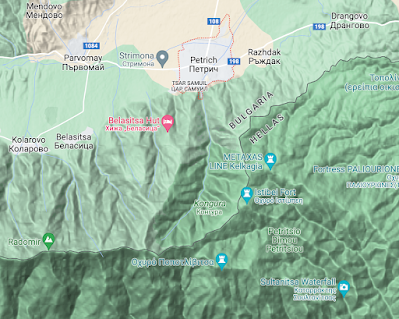I do like an obscure conflict, although I won’t turn this one into a book! I was looking for a small-scale battle for a midweek game over Zoom with a friend from Greece. When researching something else, I had come across the Incident at Petrich and thought it might make an interesting game.
The Incident at Petrich in October 1925 was a border clash between Greek and Bulgarian forces near the town of Petrich, which is in modern-day Bulgaria. The incident had its roots in territorial disputes and ethnic tensions that had been simmering in the region for years. Greece and Bulgaria were among the countries attempting to redraw their borders, particularly in the region of Petrich. The dispute centred on the border demarcation established by the Treaty of Neuilly in 1919, which required Bulgaria to cede various territories after being defeated in WW1. The population in the disputed area was ethnically diverse, with Greek and Bulgarian people residing there. This diversity contributed to ethnic tensions and territorial claims.
The incident occurred on 18 or 19 October, 1925, when a border dispute escalated into a military confrontation. Greek and Bulgarian troops clashed near Petrich, resulting in casualties on both sides.
Unsurprisingly, there are differing explanations of how it started. One version claims a Greek soldier ran over the border chasing his dog (hence, it is sometimes referred to as the War of the Stray Dog), and the soldier was shot by Bulgarian sentries. The second version claims that Bulgarian troops crossed the border and killed a Greek officer and sentry. We have no idea what happened to the dog before anyone asks!
The Bulgarian government apologised and said it was a misunderstanding. The Greek government issued an ultimatum demanding that those responsible be punished and wanted two million francs in compensation for the families. Greece sent troops to occupy Petrich to enforce these demands. There was some fighting, with chetas of the Internal Macedonian Revolutionary Organisation (IMRO) joining in. Petrich was the headquarters of the Macedonian-Bulgarian committee, and their cross-border raids were not uncommon. Over 50 people, primarily Bulgarian civilians, died.
The incident raised concerns of further escalation (possibly including Yugoslav or even Italian troops), and the League of Nations intervened before Greek troops crossed the border. However, some newspapers claimed they captured the town. The League mediated negotiations between Greece and Bulgaria to defuse the situation, and in 1927, Greece and Bulgaria signed the Petrich Agreement (also known as the Treaty of Petrich). This agreement included compensation on both sides, redefined the border in the Petrich area and established mechanisms for resolving future disputes peacefully.
The number of troops involved is unclear, although the initial Greek information was that they had been attacked by a regular Bulgarian battalion with machine guns. This sounds unlikely and is more likely to reflect the febrile state of the Greek war ministry at the time. The response was to order the Greek 3rd and 4th Corps to advance to the border. Again, it is unclear how many troops were actually sent. The Bulgarians got less excited and treated it as another border incident, ordering its forces into defensive positions with orders only to fire if attacked. The Bulgarian army was limited under the Treaty of Neuilly to 20,000 men, with a further 13,000 para-military forces and frontier guards. This meant they would be heavily outnumbered by the Greek army in any protracted conflict.
The terrain around Petrich is mountainous, with peaks of 1400-1600 metres. The Metaxas line fortifications, which gave the Germans so much trouble in 1941, marked on this map, hadn’t been built in 1925. So, my Bulgarians have taken up defensive positions in light cover, and a much stronger Greek force makes the attack. The Greeks may have had some mountain artillery, but this would have been an infantry battle.
We used my 15mm figures of the period. According to Knotel, the Greek uniforms had stayed the same. He is less clear about the Bulgarians, who apparently reverted to their early war uniforms from the predominately late-war German ones. Either way, not even I will be building a fresh army for this conflict!
Further reading, although this is focused on the diplomacy:
J. Barros, The Greek-Bulgarian Incident of 1925: The League of Nations and the Great Powers, (Proceedings of the American Philosophical Society, Vol. 108, No. 4, Aug. 27, 1964), pp. 354-385.



Nice summary of a rather obscure little clash.
ReplyDeleteI do vaguely recall reading about this matter - doubtless another of those occasions where I read an article on Wikipedia which mentioned something else. So you follow that link to another page, read about that, discover it refers to something else yet again and you keep on “moving off at a tangent”. I’ll never game this conflict, but it’s always good to read about weird, unusual and unlikely events - just in case you can include something similar as a random event in your own games.
Cheers,
Geoff
That's probably how I got there. We have a cat, so it must have been a balkan related search!
Delete